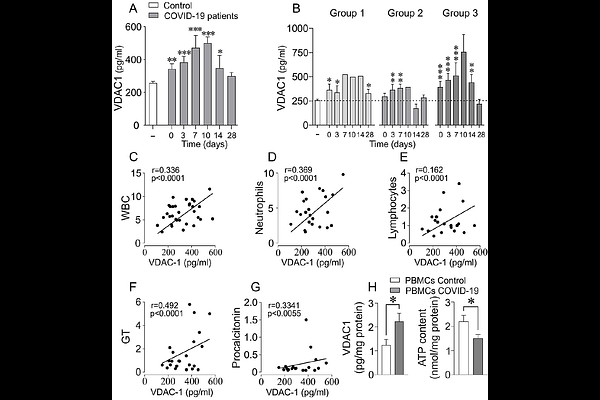Shedding of mitochondrial Voltage-Dependent Anion Channel-1 (VDAC1) Reflects COVID-19 Severity and Reveals Macrophage Dysfunction

Shedding of mitochondrial Voltage-Dependent Anion Channel-1 (VDAC1) Reflects COVID-19 Severity and Reveals Macrophage Dysfunction
Sjogren, M.; Duner, P.; De Marinis, Y.; Neumann, A.; Leandersson, K.; Rasmussen, M.; Wollheim, C. B.; Salehi, A.
AbstractCOVID-19 severity correlates with lymphopenia and increased pro-inflammatory cytokines. However, the dysfunction of tissue macrophages in COVID-19 patients during the inflammatory cytokine storm has not been fully elucidated. Hospitalized COVID-19 patients were divided into three groups based on their symptomatic severity: exhibiting mild, moderate, or severe symptoms. Patients exhibited successively increased serum levels of mitochondrial voltage-dependent anion channel 1 (VDAC1) at days 0, 3, 7, 10, and 14, returning to those of non-infected subjects at day 28. Serum level of VDAC1 was positively correlated with COVID-19 severity and with increased white blood cell (WBC), neutrophil, lymphocyte, procalcitonin (PCT), and gamma-glutamyltransferase (GT) levels. Peripheral blood mononuclear cells (PBMCs) from hospitalized COVID-19 patients showed increased VDAC1 content concomitant with a reduced ATP content. Culture of monocytes, isolated from healthy individuals, and differentiated into polarized M1 macrophages, together with a cytokine mixture (IL-1{beta}, IFN-{gamma}, and TNF-), to mimic the inflammatory cytokine storm, for 24 h markedly increased VDAC1 and Monocyte chemoattractant protein-1 (MCP-1) release in culture medium. The presence of the cytokine mixture reduced the ATP content, cell viability, and the phagocytic capability of macrophages. Co-staining of VDAC1 and the plasma membrane marker Na+/K+-ATPase showed that cytokine-treatment mistargeted VDAC1 to the cell surface of macrophages. All these effects were prevented by VDAC1 inhibition using VBIT-4, VDAC1-specific antibody (VDAC1-ab), or metformin. Our findings indicate that increased VDAC1 expression and cell surface mistargeting in immune cells might be associated with cell dysfunction, potentially contributing to the severity of COVID-19 infection. The data also indicate serum VDAC1 as a biomarker of COVID-19 severity and the use of VDAC1 inhibitors as potential drug candidates restoring macrophages and PBMCs function in individuals severely affected by COVID-19.